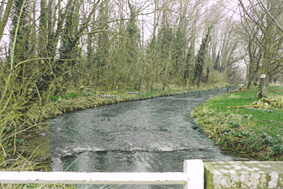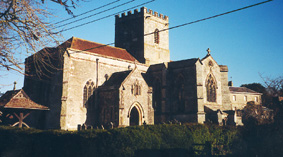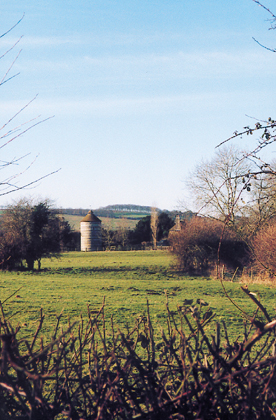A collection of deeds, which were translated in the 17th century, gave
detailed accounts of the ownership of Faulston House and Manor, through
successive generations, dating back to the le Tablier family in the
14th century
![]()
A noble
old-fashioned house with a moat and home to the Bayntuns for nine generations
over a period of 250 years
![]()
The Manor of Faulston was part of the parish of Bishopstone in the Valley of Ebble, in the south of the county of Wiltshire – about five miles south west of Salisbury and approximately 30 miles from Bromham. It was the home of the Bayntun family for nine generations from 1328 to 1508 and remained in the family until 1577.
 |
Today the stream (pictured left) runs silently through the area – as it has done for centuries. On the left of the river is the area known to locals as The Wilderness and on the opposite side of the water, where the river branches off briefly to the right, may have been the spot where the stream fed the moat that surrounded Faulston House. There is nothing left of this fine old house today, but for one of the towers, which stands alone as a symbol of the past. |
As early as 1066 the manor was acquired by William de Braose but the
overlordship of Faulston Manor was held of the Bishops. Bishopstone
was so called because it was a living of the Bishops in Winchester.
Records show Thomas le Tablier was Lord of the Manor of Faulston in the 13th century and was succeeded by his son Guy le Tablier some time before 1300. His sister, Edith, was at the time married to Richard de Grimstead and upon the death of her brother, she was heiress to Faulston and in possession of it in 1309. She had two children – Margaret and Thomas.
An Indenture, dated 13 Edward II (1320) between Richard de Grimstead and John de Farley shows Richard de Grimstead granting to his son, Thomas, the Manor of Faulston. Another document shows Thomas de Grimstead, Lord of Faulston by a deed dated 14 Edward II (1321). However, when Thomas died in 1328 without heir, his wife Joan, was given a third share of her husband's property.
His sister, Margaret de Grimstead, was married to THOMAS BAYNTUN (1300 - 1358) and she received Faulston House as part of the remaining two thirds share in the division of the property and therefore her husband, Thomas, became Lord of Faulston by right of his wife. Records show that Thomas Bayntun – or Thomas de Benton as he was then known – was Lord of Faulston in 9 Edward III (1336) and 14 Edward III (1341).
Margaret de Grimstead died in July 1340 and Thomas Bayntun died on 28th May 1358 and was succeeded by his son NICHOLAS BAYNTUN (1334 - 1372).
Land deeds indicate the latter was known as Nicholas de Benton and he inherited his father's two-thirds share in the Manor of Faulston, but by 1361 he also inherited Joan de Grimstead's one-third share when she died and so the whole manor house and farm of Faulston were reunited.
The Manor of Faulston is known to have consisted of Faulston House, a messuage (ie: a dwelling place with outbuildings and adjacent land), courtyards, a pond, two gardens, pasture, fruit trees, a mill and 250 acres of arable, together with 6 acres of meadow and the Oxedowne, shared with the tenants and some land in Croucheston and Throope. There was also grazing for 300 sheep, some of it enclosed.
By 1370 there was unrest in the country among tenants, the other Bishopstone manors altered their demands for services, or gave their tenants leases and freedom to farm for themselves, but perhaps the Bayntuns were less understanding.
When Nicholas died in 1372 he was succeeded by his eldest son and heir, also named NICHOLAS BAYNTUN (1358 - 1412). A deed dated at Fallersdon, 45 Edward III (1372) most likely his father's will, shows the clerk, Thomas de Borestoke conceding the Manor of Faulston to Nicholas de Benton and his wife Joan. Witnessed by Nicolaus de Bonham, Henry Gilbert, Oliver Harnham and John Leigh.
According to the Calendar of Patent Rolls (1374 - 1377), on the 10th October 1376 Nicholas asked for a royal licence to crenellate the walls of his manor house at Faulston to protect himself from the unrest in the county among tenants and this licence was granted at Westminster by King. Edward III. The farm was enclosed and run with paid labour, with the tenant farmers losing all their strips of land in the common fields.
Faulston, was at that time, a noble old-fashioned house and he built four towers around it, added a drawbridge and a moat and crenelated his strong high walls embattled which consisted of freestone and a layer of flints squared and headed. Two of the towers faced south, one east and the other west. It was the only fortified house in the parish – almost a castle. The towers were of alternate bands of stone and faced flint, and date from the licence to crenellate.
The house may have lain within the walled enclosure or have formed one side of it, with a walled court to the south. This was later referred to as The Pale. The enclosure was effective in 1618 when the Pale was marked on a map as a park.
The south-west corner of the house was of similar character to the towers and the main east wall of the house had in it four doorways of late 15th or 16th century character which suggests that it may have been part of a screens passage or entrance hall.
But despite his strengthened house, Nicholas Baynton, the owner of Faulston Manor, had trouble with his bondmen in 1387 when they confederated against him. But he was not the only landlord to have such an uprising among his people – owners all over the country were in similar difficulties.
The next year, 1388, Nicholas asked for an inquiry into the affairs of two of the chapels. It appears that several vicars had not been attending to their duties as often as they were supposed to and following this inquiry, the services took place more regularly in the chapels, as well as baptisms, marriages and burials. The vicar said that the predecessors of the present Lord of Faulston, their wives and tenants, had all been buried at the Faulston Chapel.
 |
John Aubrey, who lived in nearby Broad Chalke wrote about the parish Church of St. John The Baptist, Bishopstone (pictured left). It was built c1250 and once had the arms of the Bayntun family emblazoned on the east window of one of its additions, dating from Henry VI (1461 - 1471). There is however no trace of these stained glass windows today, which have been replaced, following their destruction over the centuries. |
In the 14th and 15th century however, this church had two chapels associated with it – one in Flamston and the other in Faulston – to serve the communities distant from the church. Very little is known about them, no record of where they were, or when they were abandoned. In 1320, Sir Richard Grimstead was buried in the Faulston Chapel after his body was brought over from France.
The Chapel at Faulston was not part of Faulston House. It was definitely a separate building and is described in the Inquisition Post Mortem of Richard Grimstead in 1328, with the other buildings near Faulston Manor House. It was called the Chapel of St. Andrew and St. Mary Magdalen, standing somewhere between Faulston Manor House and Chapel Close. It stood with the road to the south of it, a granary also to the south, to the west of it was a chamber with solar above and another house called Little Grange close by.
Vicars
regularly served it in the 14th century and in 1389 the inhabitants'
rights to burial, marriage and baptism there were acknowledged. The
chapel was still in use in 1406 and the last mention of the chapel
was in a will of 1420.
 |
There was a square field known as Chapel Close shown on a map dated 1792, which might have been either the site of the chapel or a field attached to the chapel. The photo (on the left) is a view looking west. Chapel Close is in the foreground. There are no visible signs of the old chapel or any graves today, apart from a few bumps in the ground, which may, or may not be, the ancient foundations. The ground is now just a small meadow and there have never been any excavations there. Nicholas Bayntun died in 1404 and was succeeded by his eldest son and heir NICHOLAS BAYNTUN (1382 - 1422) and records show he was Lord of the Manor of Faulston and also of part of the Manor of Compton Chamberlayne in the next valley to the North, the Nadder. A further deed, dated 14 Henry IV (1415), witnessed by Oliver Cervington, Henry Gilbert, Thomas Meriel and Thomas Martin again notes Nicholas Bayntun as Lord of the Manor of Faulston. |
Nicholas Bayntun died in 1422 and his wife Joan de la Roche survived him and re-married again in 1429. At the time of this marriage she conveyed the Manor of Faulston to her son, JOHN BAYNTUN (1407 - c1447).
A collection of deeds transcribed in the 17th century, show Sir John Bayntun living at Faulston in 25 Henry VI (1447).
When Sir John died he was succeeded by his eldest son, also called JOHN BAYNTUN (c1424 - 1465) and he in turn was succeeded by his eldest son and heir, SIR ROBERT BAYNTUN (1439 - 1473). After her husband's death, Katherine Payne, re-married again and when she died in 1473, the Manor of Faulston was passed onto her son Robert.
The Bayntun family had long been supporters of the House of Lancaster and as a Partisan, in the Wars of the Roses, Sir Robert Bayntun fought for King Henry VI against the forces of King Edward IV at the Battle of Tewkesbury on May 4, 1471. Henry was defeated and Sir Robert was immediately declared a traitor, thereby losing all his property, including the Manor of Faulston.
After the battle Sir Robert was made prisoner but was spared, however he died two years later. From the time he was attained, Faulston House and manor ceased to be the home of the Bayntun family for more than 30 years and the Manor of Faulston was granted to John Cheyne, who was the Lord Chief Justice .
When Sir Robert Bayntun died in 1473, he was succeeded by his eldest son and heir, JOHN BAYNTUN (1460 - 1516).
But in 1484 John Cheyne was himself attained, following the rebellion against Richard III and the Manor of Faulston was granted to George Nevill. After the Battle of Bosworth, the Manor was restored again to Cheyne and after he died, it was passed onto one of his heirs.
However on the 1st July 1504, John Bayntun obtained a reversal of the attainder of his father, Robert Bayntun, for high treason committed at Tewkesbury, with a restoration in blood and inheritance and thus recovered the many family manors, including Faulston.
Four years later, he inherited a fortune in land and property from his first cousin, thrice removed, Sir Richard Beauchamp - Lord St. Amand who died without legitimate issue in 1508. Afterwards, the Bayntun family dispersed to occupy Beauchamp property, including Bromham Hall in Bromham and as a result Faulston House ceased to be the family's main residence, although it remained Bayntun property for many years after and the main branch of the family appear to have resided thereafter at Bromham.
It is not known who lived at Faulston House after John Bayntun moved into old Bromham Hall in 1508. It is very likely one of his sons may have occupied the house.
John Bayntun was mentioned in a Tourn (a type of Court Roll for the local business of the village), as John Bayntun knight, holding one knights fee, military service in Faulston in 1506. However the inscription on the brass slab in his memory does not indicate he was knighted. Instead he is referred to as John Bayntun, Arminger (esquire – entitled to bear arms without being knighted).
When John died on 31st October 1516 he was succeeded by his eldest son, SIR EDWARD BAYNTUN (1480 - 1544) and some years after Sir Edward's death an interest in the Manor of Faulston was conveyed to his wife, Isabel, but she declined it. However in 1577 her son, SIR EDWARD BAYNTUN (1517 - 1593) sold Faulston House and the Manor of Faulston to Thomas Vaughan of Bredwardine, Co. Hereford. Thomas Vaughan had in his possession a collection of deeds which were translated in the 17th century, giving detailed accounts of the ownership of Faulston House and Manor through successive generations, dating back to the le Tablier family in the 14th century.
During the English Civil War (1642 - 1648) a garrison of soldiers were put into Faulston House and it was used as the headquarters of the Roundheads. At that time Sir George Vaughan was in possession of Faulston House and a member of the Royal army and was wounded at the Battle of Lansdown in 1643.
Also during this time, Bromham House – a mansion built by Sir Edward Bayntun (1480-1544), was put to fire by the Royalist troops from the Devizes Garrison on 5th May 1645 and was completely destroyed. A year after the Civil War, in 1649, Faulston House was sold to Lord Pembroke. Faulston House was reconstructed around this time also, with traces of mullioned windows of that period in the north and west walls, according to a description by Aubrey in 1645.
By 1650 the garrison was gone and most of the moat was filled in, the high wall pulled down and one of its towers. A lease document, dated 1666, describes Faulston House with most of its fortifications gone and only one tower left. The remaining tower is still standing today in excellent repair, its masonry being in the highest preservation and bearing ample testimony of our antiquary's accuracy of description.
Flint with dressed limestone bands, conical tiled roof with raised conical louvre and apex. This tower, when first built, would have been of several storeys. It now serves as a Dovecot – a roosting place for doves or pigeons. The last section of the moat was in the garden and was filled in some time in 1933. It was filled in to make way for a swimming pool and the circular foundation of the third tower was still visible before the war.
The site on the borders of the stream, where Faulston House once stood is now occupied by a farmhouse built in the Victorian era (pictured below), also known as Faulston House. The house was remodelled in the early 19th century when the south entrance front was refenestrated and the present staircase was inserted, and again later in that century when the kitchen was partly rebuilt, and perhaps reduced in size, and the interior was refitted.
 |
One of
the original towers (pictured left), but the adjoining
property is not part of the original structure of the old
house and little evidence exists today of its former grandeur.
However it is thought that the centre of the present house,
and the way down to the cellar, is quite ancient, and may
be the remains of the old Manor House. |
A great deal of information in this article was given to me by Elizabeth Gallop of Bowerchalke, Salisbury – author of Bishopstone, which deals with the history of Bishopstone, Faulston and surrounding areas, which was originally published in 1988. You can obtain a copy of her book by contacting: Liz.Gallop@ic24.net. Most of the photographs were taken by Dot Gulliver of Salisbury, who grew up next to Faulston House farm and her knowledge of the area and contribution was also of great help to me in compiling this article.

